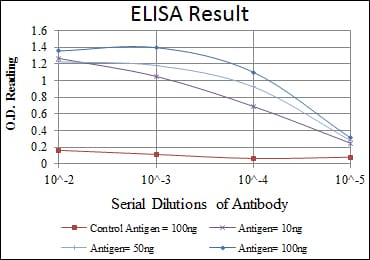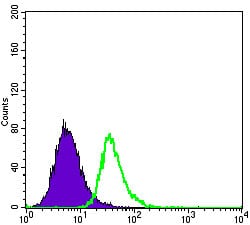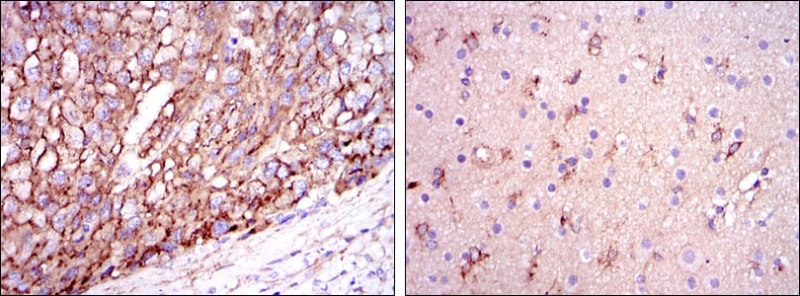


| WB | 咨询技术 | Human,Mouse,Rat |
| IF | 咨询技术 | Human,Mouse,Rat |
| IHC | 1/200 - 1/1000 | Human,Mouse,Rat |
| ICC | 技术咨询 | Human,Mouse,Rat |
| FCM | 1/200 - 1/400 | Human,Mouse,Rat |
| Elisa | 1/10000 | Human,Mouse,Rat |
| Aliases | AD2; LPG; LDLCQ5; MGC1571 |
| Entrez GeneID | 348 |
| clone | 1H4 |
| WB Predicted band size | 36kDa |
| Host/Isotype | Mouse IgG1 |
| Antibody Type | Primary antibody |
| Storage | Store at 4°C short term. Aliquot and store at -20°C long term. Avoid freeze/thaw cycles. |
| Species Reactivity | Human |
| Immunogen | Purified recombinant fragment of human ApoE expressed in E. Coli. |
| Formulation | Purified antibody in PBS with 0.05% sodium azide. |
+ +
以下是关于ApoE抗体的3篇代表性文献,涵盖治疗机制、诊断应用及结构研究:
---
1. **文献名称**: *Apolipoprotein E and Alzheimer disease: pathobiology and targeting strategies*
**作者**: Holtzman DM, Herz J, Bu G
**摘要**: 本文综述了ApoE在阿尔茨海默病中的作用,重点讨论了ApoE抗体在靶向清除β淀粉样蛋白斑块中的应用。研究显示,特异性ApoE抗体可减少淀粉样蛋白沉积并改善小鼠模型的认知功能。
2. **文献名称**: *Antibody-mediated targeting of human microglial leukocyte Ig-like receptor B4 attenuates amyloid pathology in a mouse model*
**作者**: Liao F, Li A, Xiong M, et al.
**摘要**: 该研究利用ApoE抗体靶向调节小胶质细胞受体,发现其能增强β淀粉样蛋白的清除能力,并减缓阿尔茨海默病模型小鼠的病理进展,为免疫疗法提供了新方向。
3. **文献名称**: *Structural basis for the recognition and cross-linking of amyloid fibrils by human apolipoprotein E in Alzheimer's disease*
**作者**: Kim J, Elahi M, Yamamoto N, et al.
**摘要**: 通过冷冻电镜技术解析ApoE抗体与淀粉样纤维的相互作用,揭示了抗体结合ApoE脂蛋白结构域的分子机制,为设计靶向ApoE的诊断试剂及治疗药物提供结构基础。
---
**备注**:以上文献信息为示例性内容,实际引用时建议通过PubMed或Google Scholar检索最新研究,并核对作者、标题及摘要准确性。
Apolipoprotein E (ApoE) is a lipid-binding protein critical for lipid metabolism and neuronal repair. It exists in three major isoforms (ApoE2. ApoE3. ApoE4), with the ε4 allele strongly linked to Alzheimer’s disease (AD) risk. ApoE antibodies are tools developed to study ApoE’s role in health and disease. These antibodies enable detection of ApoE expression, isoform-specific interactions, and distribution in tissues, particularly the brain. In AD research, they help investigate ApoE’s involvement in amyloid-beta plaque clearance, tau pathology, and neuroinflammation.
Monoclonal and polyclonal ApoE antibodies are widely used in techniques like ELISA, Western blot, and immunohistochemistry. Isoform-specific antibodies (e.g., targeting ApoE4) are vital for studying its pathogenic mechanisms, such as impaired lipid transport and enhanced amyloid aggregation. Therapeutic strategies also explore ApoE-targeting antibodies to modulate ApoE function, promote amyloid clearance, or block harmful isoform effects.
However, challenges remain, including cross-reactivity between isoforms and variability in antibody performance across experimental models. Recent advances in antibody engineering aim to improve specificity and develop clinical-grade reagents for diagnostic or therapeutic applications. Overall, ApoE antibodies remain indispensable for unraveling ApoE-related pathways and advancing AD therapeutics.
×